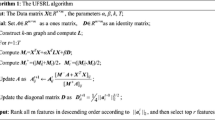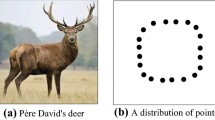Abstract
Unsupervised feature selection is an important machine learning task since the manual annotated data are dramatically expensive to obtain and therefore very limited. However, due to the existence of noise and outliers in different data samples, feature selection without the help of discriminant information embedded in the annotated data is quite challenging. To relieve these limitations, we investigate the embedding of spectral learning into a general sparse regression framework for unsupervised feature selection. Generally, the proposed general spectral sparse regression (GSSR) method handles the outlier features by learning the joint sparsity and the noisy features by preserving the local structures of data, jointly. Specifically, GSSR is conducted in two stages. First, the classic sparse dictionary learning method is used to build the bases of original data. After that, the original data are project to the basis space by learning a new representation via GSSR. In GSSR, robust loss function \(\ell _{2,r}{-}{norm}(0<r\le 2)\) and \(\ell _{2,p}-{norm}(0<p\le 1)\) instead of the traditional F norm and least square loss function are simultaneously considered as the reconstruction term and sparse regularization term for sparse regression. Furthermore, the local topological structures of the new representations are preserved by spectral learning based on the Laplacian term. The overall objective function in GSSR is optimized and proved to be converging. Experimental results on several publicly datasets have demonstrated the validity of our algorithm, which outperformed the state-of-the-art feature selections in terms of classification performance.




Similar content being viewed by others
Explore related subjects
Discover the latest articles, news and stories from top researchers in related subjects.References
Zhang S, Li X, Zong M et al (2018) Efficient knn classification with different numbers of nearest neighbors. IEEE Trans Neural Netw Learn Syst 29(5):1774–1785
Cong L, Xiaofeng Z (2017) Unsupervised feature selection via local structure learning and sparse learning. Multimed Tools Appl 77:1–18
Yu J, Gao X, Tao D et al (2014) A unified learning framework for single image super-resolution. IEEE Trans Neural Netw Learn Syst 25(4):780–792
Dash M, Liu H (2000) Feature selection for clustering. In: Pacific-Asia conference on knowledge discovery and data mining, Springer, Berlin, pp 110–121
Nie F, Xiang S, Jia Y et al (2008) Trace ratio criterion for feature selection. AAAI 2:671–676
Guyon I, Elisseeff A (2003) An introduction to variable and feature selection. J Mach Learn Res 3:1157–1182 (Mar)
Cai D, Zhang C, He X (2010) Unsupervised feature selection for multi-cluster data. In: Proceedings of the 16th ACM SIGKDD international conference on knowledge discovery and data mining, ACM, pp 333–342
Dy JG (2008) Unsupervised feature selection. In: Computational methods of feature selection, pp 19–39
Mitra P, Murthy CA, Pal SK (2002) Unsupervised feature selection using feature similarity. IEEE Trans Pattern Anal Mach Intell 24(3):301–312
Li Z, Yang Y, Liu J et al (2012) Unsupervised feature selection using nonnegative spectral analysis. In: AAAI, pp 1026–1032
Hou C, Nie F, Li X et al (2014) Joint embedding learning and sparse regression: a framework for unsupervised feature selection. IEEE Trans Cybern 44(6):793–804
Hou C, Nie F, Yi D et al (2011) Feature selection via joint embedding learning and sparse regression. In: IJCAI
Yuan M, Lin Y (2006) Model selection and estimation in regression with grouped variables. J R Stat Soc Ser B (Stat Methodol) 68(1):49–67
Peng H, Fan Y (2017) A general framework for sparsity regularized feature selection via iteratively reweighted least square minimization. In: AAAI
Peng H, Fan Y (2016) Direct sparsity optimization based feature selection for multi-class classification. In: IJCAI
Zhu X, Li X, Zhang S et al (2017) Robust joint graph sparse coding for unsupervised spectral feature selection. IEEE Trans Neural Netw Learn Syst 28(6):1263–1275
Wang Y, Wu L, Lin X et al (2018) Multiview spectral clustering via structured low-rank matrix factorization. IEEE Trans Neural Netw Learn Syst 29:4833–4843
Wang Y, Lin X, Wu L et al (2015) Robust subspace clustering for multi-view data by exploiting correlation consensus. IEEE Trans Image Process 24(11):3939–3949
Zhao Z, Wang L, Liu H (2010) Efficient spectral feature selection with minimum redundancy. In: AAAI, pp 673–678
Kohavi R, John GH (1997) Wrappers for feature subset selection. Artif Intell 97(1–2):273–324
Wang Y, Wu L (2018) Beyond low-rank representations: orthogonal clustering basis reconstruction with optimized graph structure for multi-view spectral clustering. Neural Netw 103:1–8
Constantinopoulos C, Titsias MK, Likas A (2006) Bayesian feature and model selection for Gaussian mixture models. IEEE Trans Pattern Anal Mach Intell 6:1013–1018
Wang Y, Lin X, Wu L et al (2017) Effective multi-query expansions: collaborative deep networks for robust landmark retrieval. arXiv preprint arXiv:1701.05003
Parthalin NM, Jensen R (2010) Measures for unsupervised fuzzy-rough feature selection. Int J Hybrid Intell Syst 7(4):249–259
Zhu X, Wu X, Ding W, et al (2013) Feature selection by joint graph sparse coding. In: Proceedings of the 2013 SIAM international conference on data mining. Society for industrial and applied mathematics, pp 803–811
Wu L, Wang Y, Gao J et al (2018) Deep adaptive feature embedding with local sample distributions for person re-identification. Pattern Recognit 73:275–288
Liu J, Ji S, Ye J (2009) Multi-task feature learning via efficient \(\ell _{2,1}-norm\) minimization. In: Proceedings of the twenty-fifth conference on uncertainty in artificial intelligence, AUAI Press, pp 339–348
Chartrand R (2007) Exact reconstruction of sparse signals via nonconvex minimization. IEEE Signal Process Lett 14(10):707–710
Zeng J, Lin S, Wang Y et al (2014) \(L_ 1/2\) Regularization: convergence of iterative half thresholding algorithm. IEEE Trans Signal Process 62(9):2317–2329
Shao L, Yan R, Li X et al (2014) From heuristic optimization to dictionary learning: a review and comprehensive comparison of image denoising algorithms. IEEE Trans Cybern 44(7):1001–1013
Mairal J, Bach F, Ponce J et al (2010) Online learning for matrix factorization and sparse coding. J Mach Learn Res 11:19–60 (Jan)
Mairal J, Bach F, Ponce J et al (2009) Online dictionary learning for sparse coding. In: Proceedings of the 26th annual international conference on machine learning, ACM, pp 689–696
Zheng W, Zhu X, Wen G et al (2018) Unsupervised feature selection by self-paced learning regularization. Pattern Recognit Lett. https://doi.org/10.1016/j.patrec.2018.06.029
Yang Y, Shen H T, Ma Z, et al (2011) \(\ell _{2,1}-Norm\) regularized discriminative feature selection for unsupervised learning. In: IJCAI proceedings-international joint conference on artificial intelligence, vol 22, no 1, p 1589
Zhu X, Zhang S, Li Y et al (2018) Low-rank sparse subspace for spectral clustering. IEEE Trans Knowl Data Eng. https://doi.org/10.1109/TKDE.2018.2858782
Zhu X, Zhang S, Hu R et al (2018) Local and global structure preservation for robust unsupervised spectral feature selection. IEEE Trans Knowl Data Eng 30(3):517–529
Zheng W, Zhu X, Zhu Y et al (2018) Dynamic graph learning for spectral feature selection. Multimed Tools Appl 77(22):29739–29755
Geng B, Tao D, Xu C et al (2012) Ensemble manifold regularization. IEEE Trans Pattern Anal Mach Intell 34(6):1227–1233
Zhang Q, Zhang L, Zhang L et al (2015) Ensemble manifold regularized sparse low-rank approximation for multiview feature embedding. Pattern Recognit 48(10):3102–3112
Nie F, Huang H, Cai X, et al (2010) Efficient and robust feature selection via joint \(\ell _{2,1}-norm\) minimization. In: Advances in neural information processing systems, pp 1813-1821
Zhu X, Zhang S, He W, Hu R, Lei C, Zhu P (2018) One-step multi-view spectral clustering. IEEE Trans Knowl Data Eng. https://doi.org/10.1109/TKDE.2018.2873378
Zhu X, Li X, Zhang S, Zongben X, Litao Y, Wang C (2017) Graph PCA hashing for similarity search. IEEE Trans Multimed 19(9):2033–2044
Acknowledgements
The research was supported by the National Key R&D Program of China under Grant No. 2017YFC0820604, Anhui Provincial Natural Science Foundation under Grant No. 1808085QF188, and National Nature Science Foundation of China under Grant Nos. 61702156, 61772171 and 61876056.
Author information
Authors and Affiliations
Corresponding author
Additional information
Publisher’s Note
Springer Nature remains neutral with regard to jurisdictional claims in published maps and institutional affiliations.
Rights and permissions
About this article
Cite this article
Chen, T., Guo, Y. & Hao, S. Unsupervised feature selection based on joint spectral learning and general sparse regression. Neural Comput & Applic 32, 6581–6589 (2020). https://doi.org/10.1007/s00521-019-04117-9
Received:
Accepted:
Published:
Issue Date:
DOI: https://doi.org/10.1007/s00521-019-04117-9




